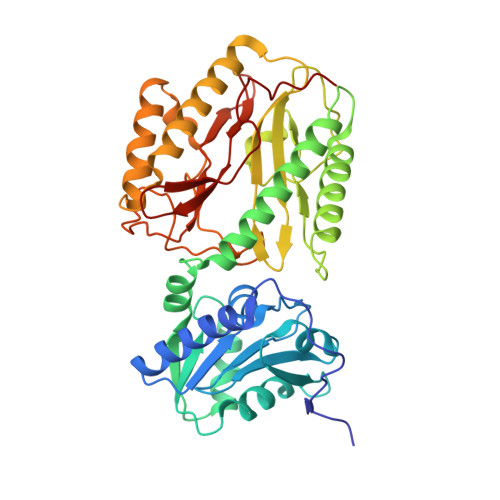Creatinase: Using Increased Entropy to Improve the Activity and Thermostability.
Jiang, F., Bian, J., Liu, H., Li, S., Bai, X., Zheng, L., Jin, S., Liu, Z., Yang, G.Y., Hong, L.(2023) J Phys Chem B 127: 2671-2682
- PubMed: 36926920
- DOI: https://doi.org/10.1021/acs.jpcb.2c08062
- Primary Citation of Related Structures:
7YTO - PubMed Abstract:
Improving protein thermostability in mutagenesis-based enzyme engineering was often achieved by enhancing interresidue interactions via mutation to increase the enthalpy penalty of unfolding. However, this approach may trade off the functional activity due to the loss of structural flexibility of the biomolecule. Here, by performing X-ray crystallography, enzymatic kinetic experiments, neutron scattering, and thermodynamical measurements, we compared the structures, catalytic behaviors, dynamics, and thermostability between a wild-type creatinase and its four-point mutant. We found that the mutant is an entropy-driven thermostable protein with higher structural flexibility, i.e., higher conformational entropy, in the folded state compared to the wild type. The increased conformational entropy of the mutant in the folded state can reduce the entropy gain during unfolding and thus renders it greater thermostability. Moreover, the increased structural flexibility, particularly around the catalytic site, can broaden the mutant's working temperature range and considerably improve its activity at ambient conditions, which is crucial for its application in diagnosing kidney diseases. Complementary all-atom molecular dynamics simulations indicated that the four mutations replaced several of the strong interresidue interactions (electrostatic interactions and hydrogen bonds) with weak hydrophobic interactions. These substitutions not only release the structural flexibility to promote the thermostability and enzymatic activity of the protein but they also preserve the protein structure from collapsing. Our findings may pave a route for the entropy-driven strategy to design proteins with high thermostability and activity.
Organizational Affiliation:
School of Physics and Astronomy, Shanghai Jiao Tong University, Shanghai 200240, China.














